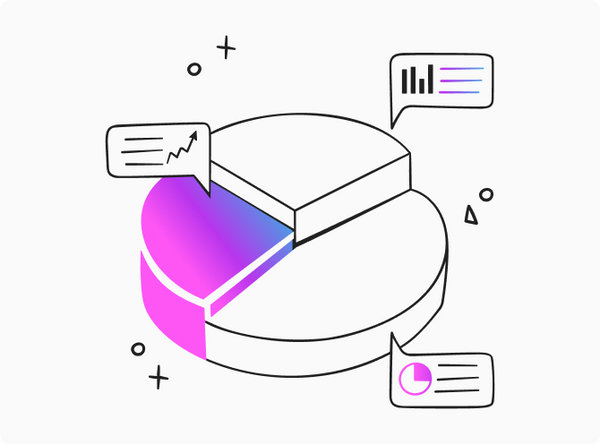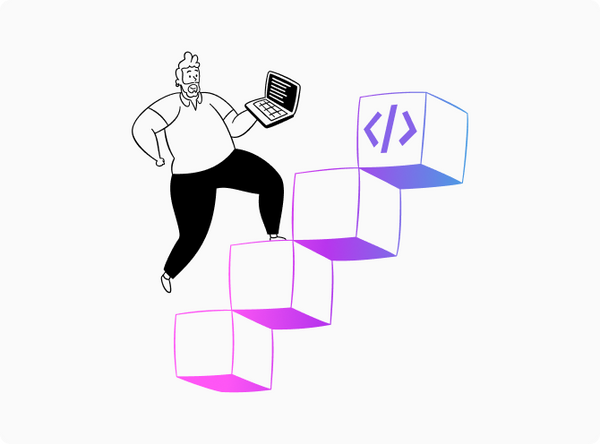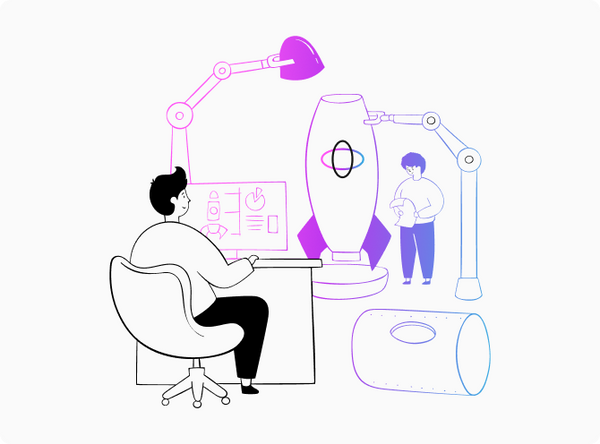
The cost of MVP development depends on a range of factors — from the type of product to the number of features integrated and the chosen development approach. In order to come up with a correct MVP estimation for your app it's necessary to know where your resources will go and the strategies you can use to optimize the expenses.
Read on to find out how app MVP pricing is calculated. Plus, all the main do's and don'ts of the development process when it comes to the project budgeting.

1. Importance of Estimating MVP Cost
Estimating and calculating MVP development cost is crucial for startups as it helps them plan their budget more effectively, set realistic expectations, allocate resources more wisely, and better prioritize the functionality of an MVP. In addition, it helps them avoid spending money on low-priority tasks or those that do not contribute to the set business goals.
It's important to understand that the actual numbers for the cost to build an MVP may greatly vary depending on the project scope, the goals set for it, the number of features, etc. So, how much does MVP cost actually?
On average, the cost of MVP development may range from $5,000 to more than $100,000. Much depends on whether you want a basic project or have multiple integrations, features, and so on. For a more accurate estimate, it's always better to consult professionals who have experience in this area.

2. What Factors Affect the Price of an MVP
MVP complexity
The complexity of an MVP is one of the biggest and most crucial factors that determines how much the development will cost. Obviously, the more complex an MVP gets, the more time and team resources will be required to launch it. If you plan to have complex integrations, use ML/AI tools, or use blockchain, be prepared not only for costly investments, but also hiring dedicated developers with experience in these areas.
On the other hand, a simple MVP, whether it is a basic website or app with a few screens, will require less time and effort to build and thus will be more cost-effective.
Features and functionality
In the same way as it is with product complexity, the more features the MVP has, the more expensive it will be to develop. Real-time data processing, integration with third-party services, complex UI, etc. all will require more time to develop, test, and deploy.
So, when developing an MVP, we recommend only adding those features that are crucial for delivering the core value to your target audience and making sure that the product concept works as intended. Normally, we talk about 2-3 main features being part of an MVP. For more about how to prioritize features, read our article here.
Development platform
This aspect is especially critical when developing mobile applications, as different platforms have different pricing structures, and some may be more expensive than others. In general, native apps are more expensive to develop compared to web-based products. Also, when you consider developing a native app, will it be for both iOS and Android platforms? Or just for one of those?
This is important since developing a product for both systems will require double the budget. Plus, it will increase the team size as the product for each system needs a specific set of skills and tech knowledge, and has to be built with its own tech stack.
Development approach
Building an MVP in-house is more costly and better fits large companies who either already have experience launching MVPs or have sufficient budgets. This allows them to cover all the expenses associated with the in-house team (salaries, software licenses, rent, utilities, taxes, etc.). On the other hand, outsourcing can be a cost-effective solution, especially for a startup with limited resources.
With an offshore team you don't have to worry about any overhead costs, hiring, managing your team, and so on. All these activities are handled by the outsourced partner. Plus, when compared to the rates of developers from the US or Canada, development quotes from Eastern European software companies can be two to three times lower.
Delivery timeframe
The longer the project takes, the more resources, development hours, and team members will be required for its completion. In addition to that, delays in delivery can lead to increased costs due to changes in project scope, additional testing or debugging.
Aside from that, there are also 'opportunity expenses', meaning a longer delivery timeframe will postpone the product release and potentially result in missed revenue opportunities or a lower audience reach.

3. What Steps in MVP Development are the Most Expensive
UI
Creating a user interface (UI) for an MVP can be expensive. It requires specialized design expertise, is a time-intensive process, and often involves deep customization to meet specific business requirements.
High-quality UI is not only about a good-looking picture, it's also about considering the user's needs, understanding their psychology, and creating interfaces accordingly. Often, the development of UI is not limited to one UI version only. So, each new iteration will require multiple rounds of design, prototyping, and testing, which can add up to the total project budget.
However, there are ways to minimize the costs of UI development. You can use pre-built UI components or dedicated services with ready page templates (in case of websites). Another way to reduce costs is to outsource this task to an offshore team.
Development
The development phase is where the actual MVP gets built. Here, you want to have developers knowledgeable in multiple programming languages and frameworks to make sure that the MVP comes out running smoothly. Higher development expertise comes at a higher rate, especially if we're looking at in-house teams.
It is important to note that the MVP development process is of the iterative nature. Meaning that eventually the product will end up having multiple iterations, and as a result, additional coding work. This can also add significantly to the project budget over time. So, make sure you plan for such expenses beforehand.
Integrations
When planning to add multiple services into your MVP, such as a payment gateway, social media platforms, email providers, analytics, video chats, etc. consider how important a particular integration is, and how much it will cost you in the long run.
In the case of a startup where the budget is usually tight, you want to ensure that every penny works for you. Paying for extra fees or licenses that may not be that crucial at the MVP stage can eat up much of your resources, so wait until they are necessary.
Maintenance
Once your MVP gets launched, it will require ongoing maintenance and support to ensure it stays functional and up-to-date. Maintenance includes bug fixing, security testing, and software updates, to name a few. Add to that customer support, and the overall cost can become quite significant, especially if you have a large user base.
The price tag here can also vary too, depending on the level of maintenance required. So, as with the previous points the general recommendation here would be the same: focus on what's crucial for the core concept of your MVP and build your work around those areas.
4. What Does It Cost to Build an MVP: In-house vs Outsource vs Freelance
There are three main development approaches you may choose to take for your MVP. You can create a product with your in-house team, outsource it to an offshore partner, or hire freelancer(s) to carry out the project for you. Here are the main pros and cons of each of them:
- In-house development. Building an MVP in-house is often considered the most expensive option. It involves putting together an entire team by hiring developers, UX/UI designers, project managers, business analysts, and so on. On the other hand, it gives you the most control over the project and flexibility in terms of development. With this approach, the overall costs can span anywhere from $20,000 up to $150,000 depending on the project scope.
- Outsourcing. Outsourcing an MVP project is the more cost-effective option compared to doing everything in-house. Here you partially pass control over your project to the outsourcing partner, but also free up internal resources to focus on strategic goals rather than mundane tasks. The cost of outsourcing services will depend on the location of the company, the team's experience, and project requirements and may cost anywhere from $10,000 to $100,000.
- Hiring freelancer(s). This is the cheapest option. Obviously, the main advantage will be cost reduction, and with such an approach you can get an MVP for $5,000 to $50,000. However, there's a risk that the developers may disappear in the middle of the process, leaving you with an unfinished MVP. So, we recommend only going with freelancers if you've already had past experience doing projects in such a way, or have a pool of experienced freelance professionals who can help you out.
5. How Much Does MVP Cost On Average
To give you a better understanding of MVP pricing, let's look at an app cost breakdown with the development stages and team members required to deliver the project. Since the price tag for Android and iOS development are almost the same, we'll be looking at the breakdown for the basic iOS mobile application.
Note, the table offers hourly rates for an average outsourcing development team from Eastern Europe. For the US or Canada the development team costs are normally two or three times higher, so the prototype development will be 2-3 times more expensive too.

6. MVP Cost Optimization Strategies
This is an important point upon which we need to be clear — it's almost impossible to significantly reduce the Minimum Valuable Product cost while maintaining the same level of quality. However, there are still some strategies you can use to optimize your MVP, and, thus, expenses:
- Cut down the number of features — instead of trimming down the quality on 2 or 3 features, just consider developing one that would work flawlessly.
- Making it less complex — simplifying functionality will help to save on the budget. For example, instead of a fully-fledged telehealth communication tool, you can simply generate a link to Zoom or Google Meets. This way you will facilitate all the communication activities until you're ready to offer more advanced functionality to your audience.
- Simplify the UI — you can also use ready-made templates, kits, and free stock assets to minimize project expenses. The only disadvantage here is that your UI can end up being dull and look like any other interface created this way. Of course, as time goes on and you source additional funds, you can enhance the UI, making it more unique.
- Prioritize the development — don't try to do everything all at once, move step-by-step. After the basic functionality is ready, try to attract an investor who might be interested in funding the next development step of your MVP.
- Pitch your concept — this tip will work for those with a 'close to zero' budget. All you need to do here is come up with a presentation, business plan, and a clickable prototype of your MVP concept. Then, pitch this idea to potential investors to raise funds for the actual product development.

7. The Cost of Maintaining and Scaling Your MVP After Launch
Once your MVP goes live there are two types of expenses to account for: technical and non-technical. On the technical side of the project, we're looking at expenses connected with:
- Server maintenance
- Cloud services
- Hosting
- Domain
- Store publishing, etc.
As to non-technical expenses, most commonly these are:
- Support expenses (temporary)
- Marketing expenses (can be both temporary and permanent)
- Sales team (for SaaS projects)
- Taxes, etc.
Note, your main goal is to make sure your product gets to your audience, because no matter how good it is, if nobody knows about your MVP, it won't succeed. In view of this, all aforementioned expenses are necessary to support your product’s viability. The product without both technical and customer support will simply collapse, and lose all its audience. With the missing hosting or domain, users won't be able to access it, and so on, and so forth.
8. Lunka Tech Experience in MVP Estimation
The two main concerns when creating an MVP are time and money. The development process assumes that you are always on the run managing the project, seeking funding, and growing your project. These are permanent concerns you can't get rid of. But you can delegate them to a professional team who has the know-how and can take that burden off your shoulders.
Our outsourcing company specializes in delivering MVP app development services tailored to the business needs of the specific project. This ensures that the product we launch can produce a maximum effect. Our agile development process is always clear and collaborative, meaning that the client always has full visibility and control over the project, every step of the way.
We also have a track record of delivering successful MVPs for a range of clients across different industries. No matter the challenge, we’re ready to step in to help with your project!
9. Final Thoughts
The proper MVP development cost estimation done beforehand helps to give startups and businesses a peace of mind. Knowing that they have all the activities planned out and won't run out of resources in the middle of the development process, makes success one step closer.
It also allows them to adjust their strategy and identify potential risks and challenges that they may come across when creating an MVP and after its launch. It's a crucial step that should not be overlooked if you want to ensure that your project will be ready on time and within a specific budget.
If you have any questions unanswered, or want to know more about MVP app development pricing, don't hesitate to contact us today!
FAQ
How to calculate MVP?
You need to first define the scope and requirements of the MVP, assess essential features and functionality, estimate the development timeline, and decide on the development approach. Once that's done, multiply the number of hours required to complete the MVP by the hourly rate of the development team. Also, add a contingency buffer of 15-20% to the total cost to account for any unexpected costs or changes in the work scope.
How expensive is a mobile app MVP usually?
The product development cost can vary depending on several factors such as the complexity of the app, the features required, and the type of development team you hire. However, based on average industry estimates, the MVP cost can range anywhere between $5,000 to $100,000 or more.
How much does it cost to create an MVP app in 2023?
It's difficult to give the exact cost of creating an MVP app since it is subject to the app’s complexity, the features required, the development team's composition, and the desired delivery timeframe. The cost may also vary depending on the platform it is being developed for (iOS or Android) and whether it requires integration with third-party services or APIs. To get a precise estimate of the software development cost for your project, please contact our managers.
Should I prioritize cost over quality when developing an MVP?
No. While cost is an important consideration when developing an MVP, the quality of a product should always remain your #1 priority. If you have a limited budget, then it's better to minimize the number of features and come up with a less complicated UI. People can continue using an app with limited functionality, but they will hardly give a second chance to a buggy or bad-looking product.


